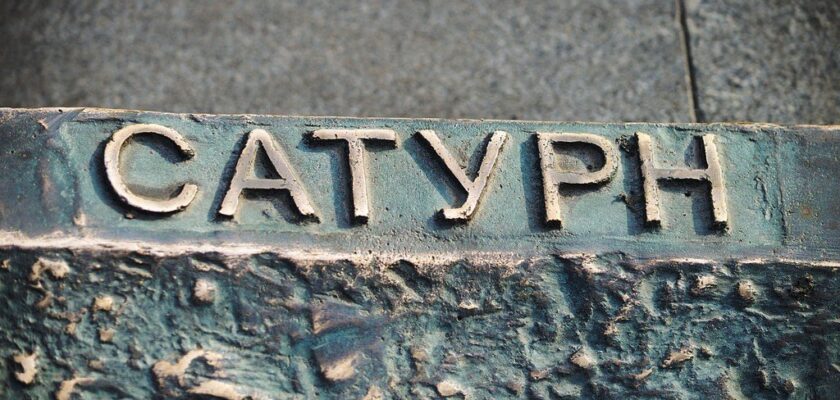All-Russian Exhibition Center
All-Russian Exhibition Center (VVC) is the country’s main exhibition, built 70 years ago and changed its name three times. Initially the achievements of the national economy were demonstrated here, now everything in the world. The All-Russian Exhibition Center holds 150 events a year and claims the right to host the world exhibition Exxpo 2020.
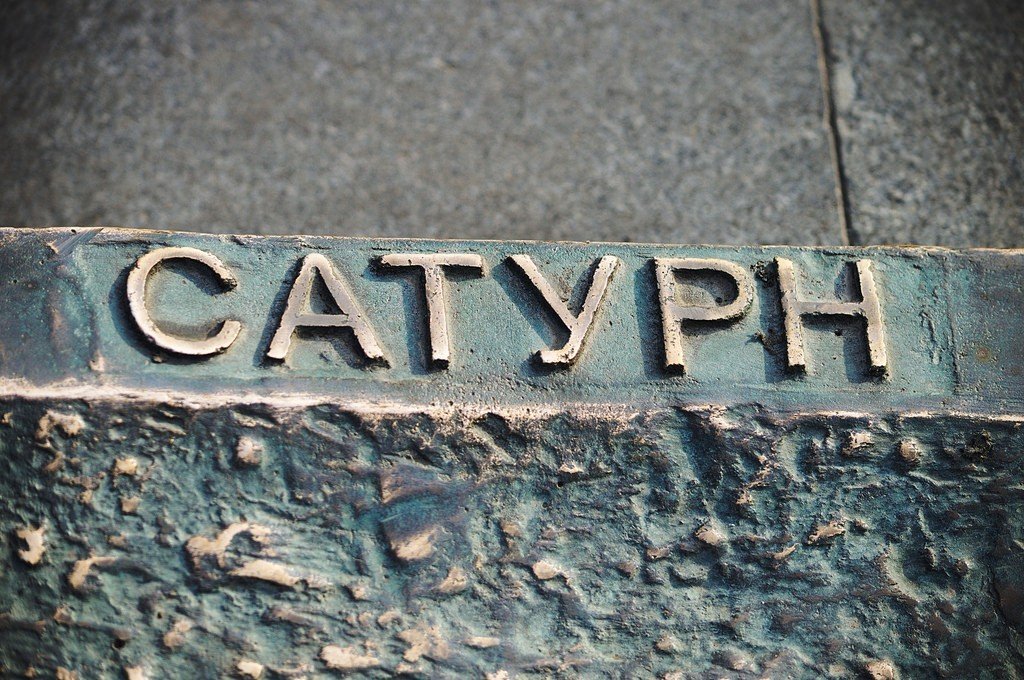
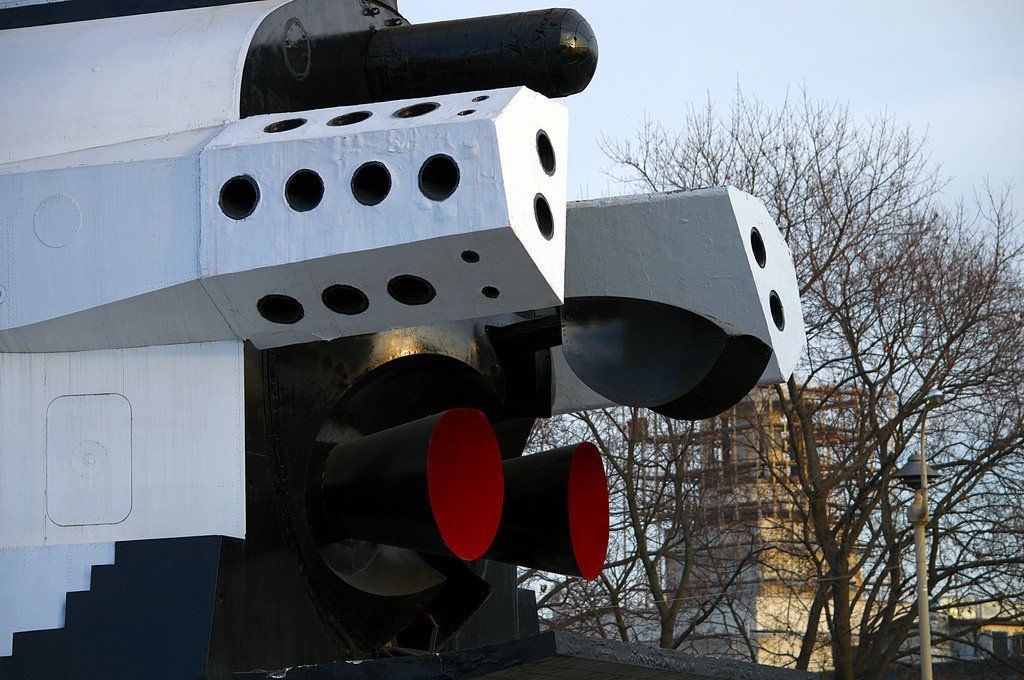
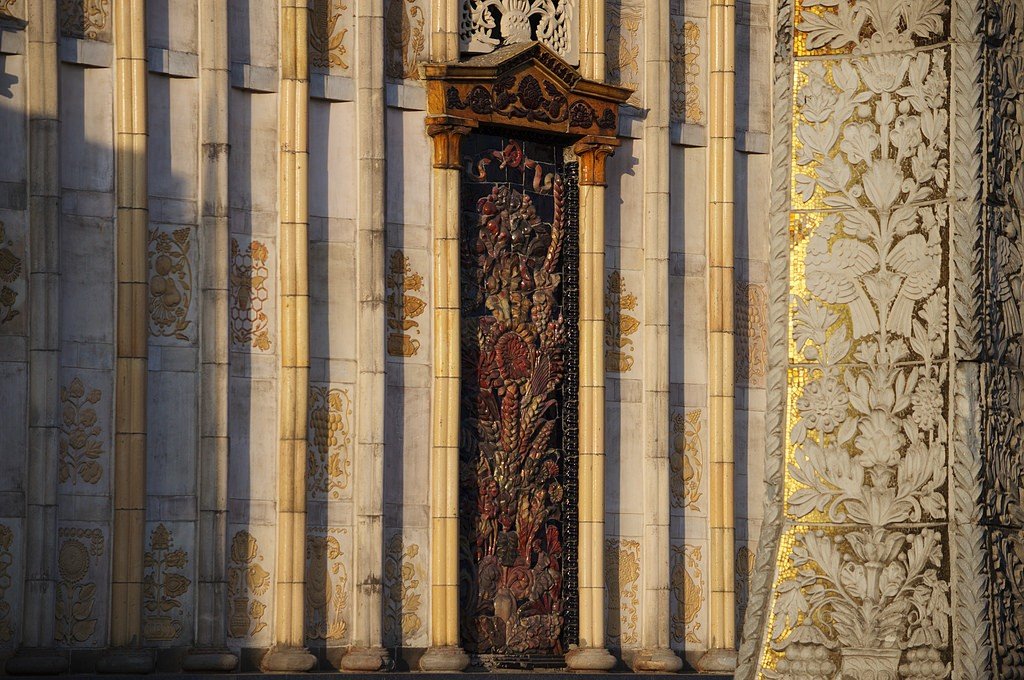
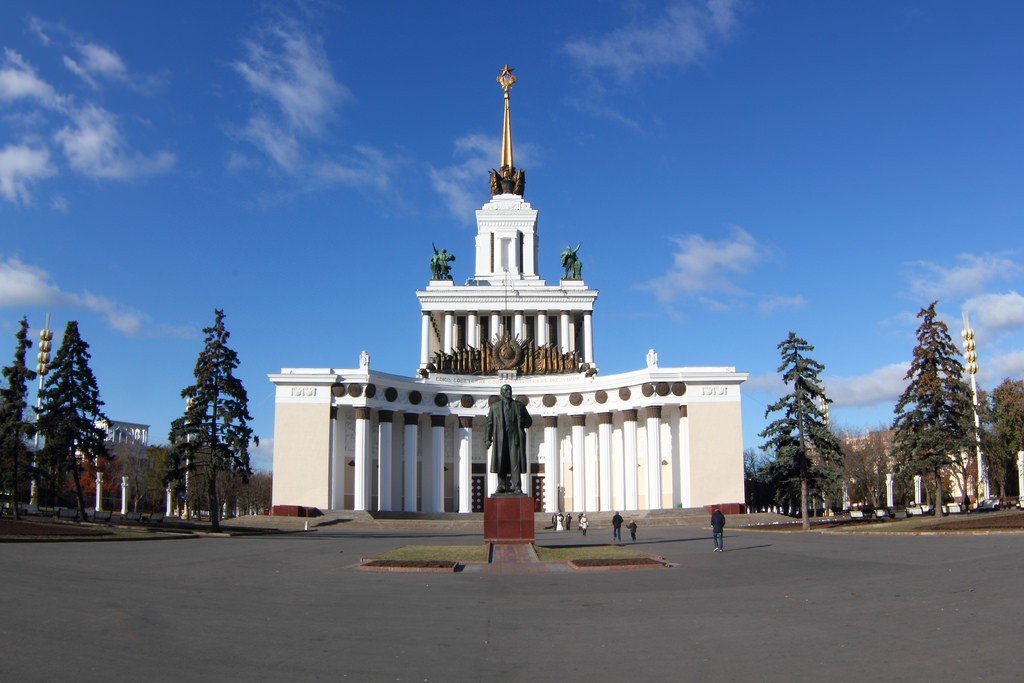
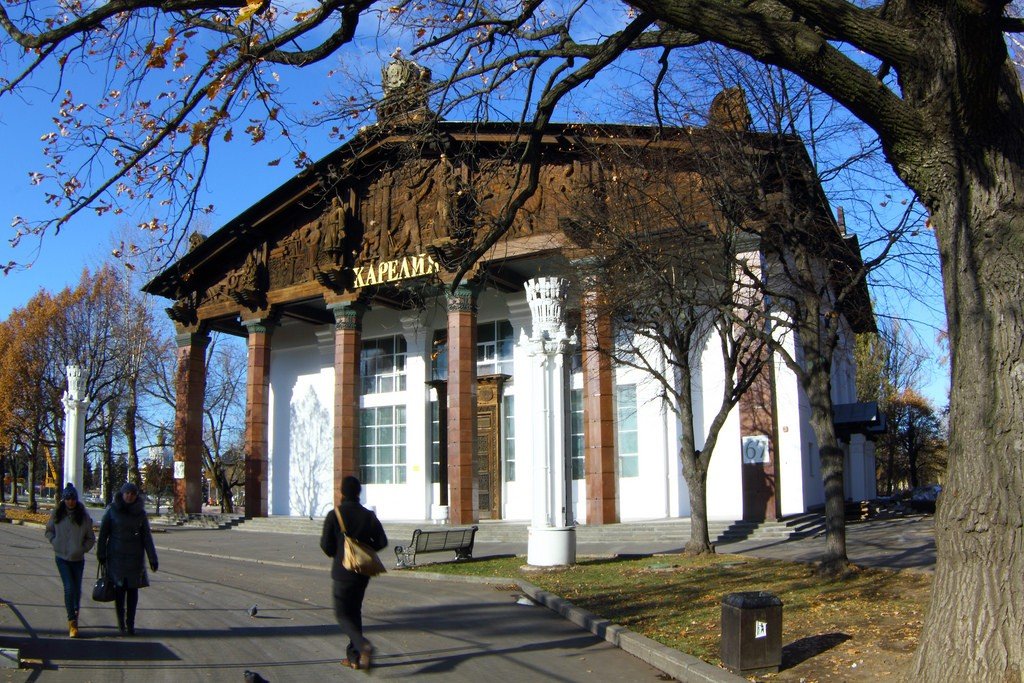
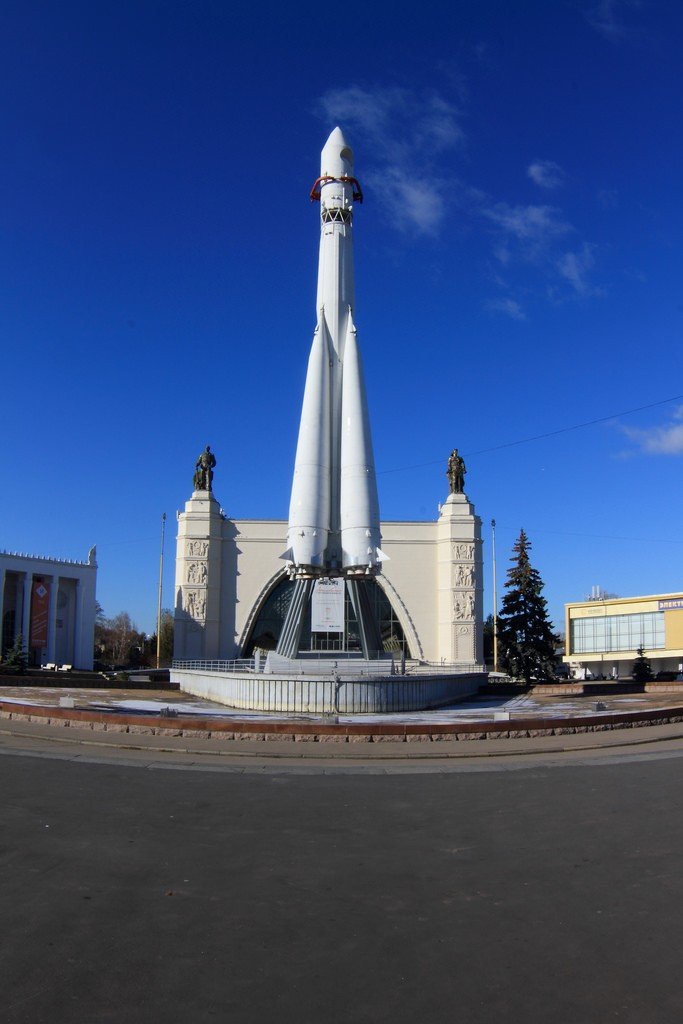
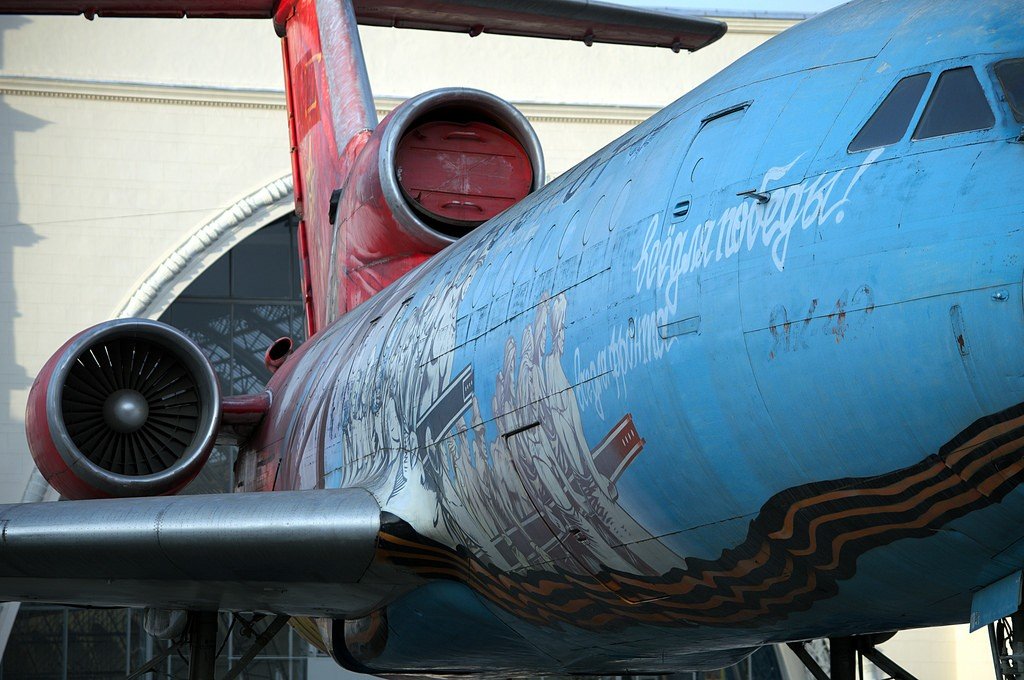
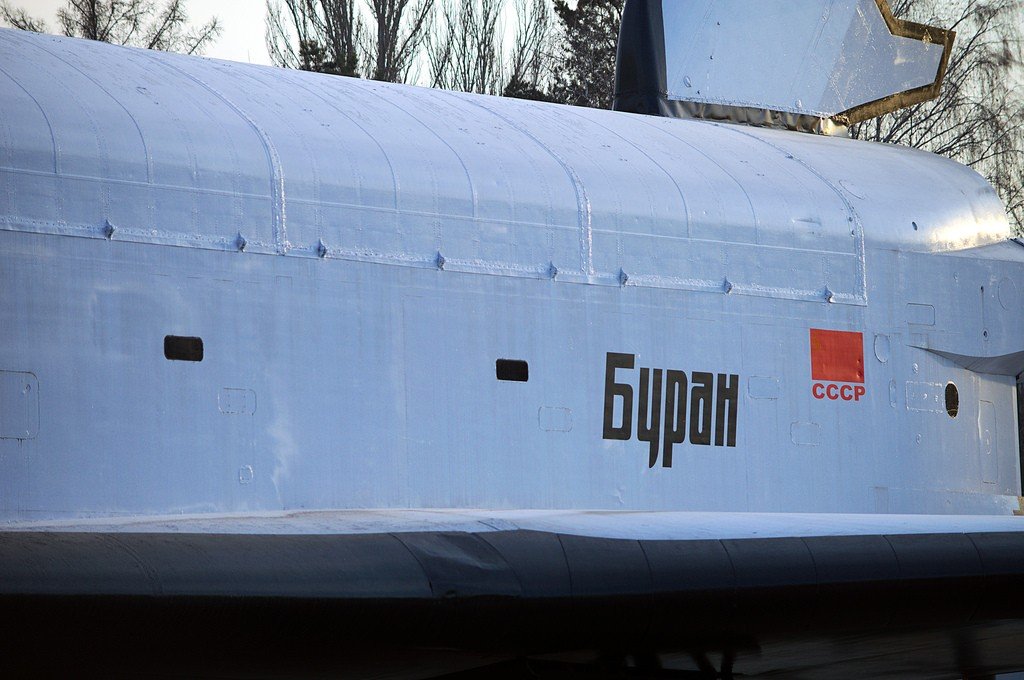
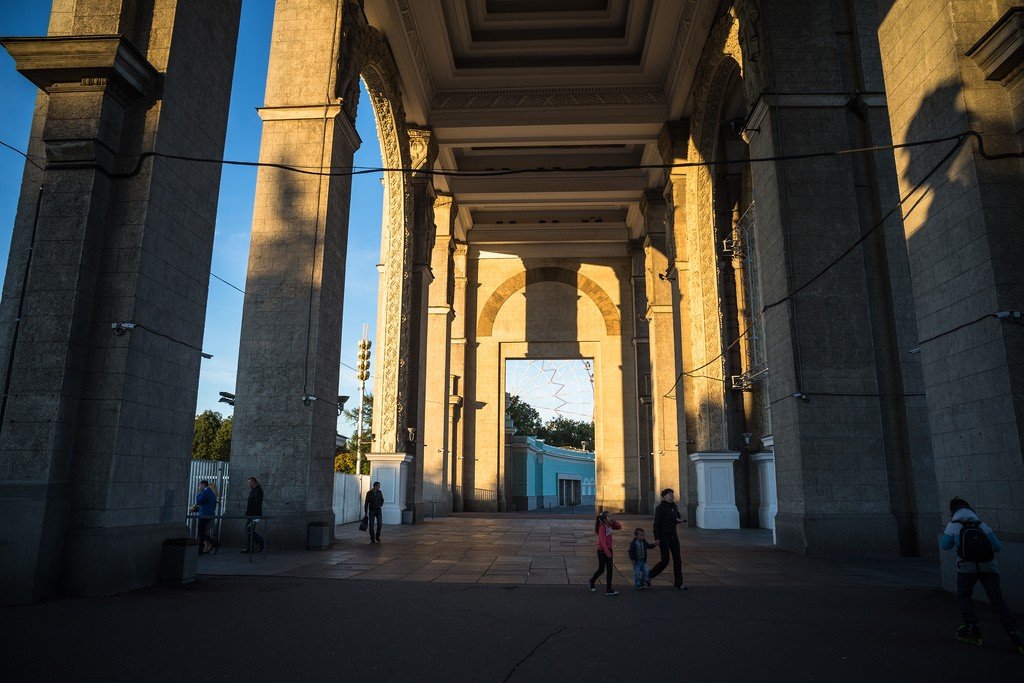
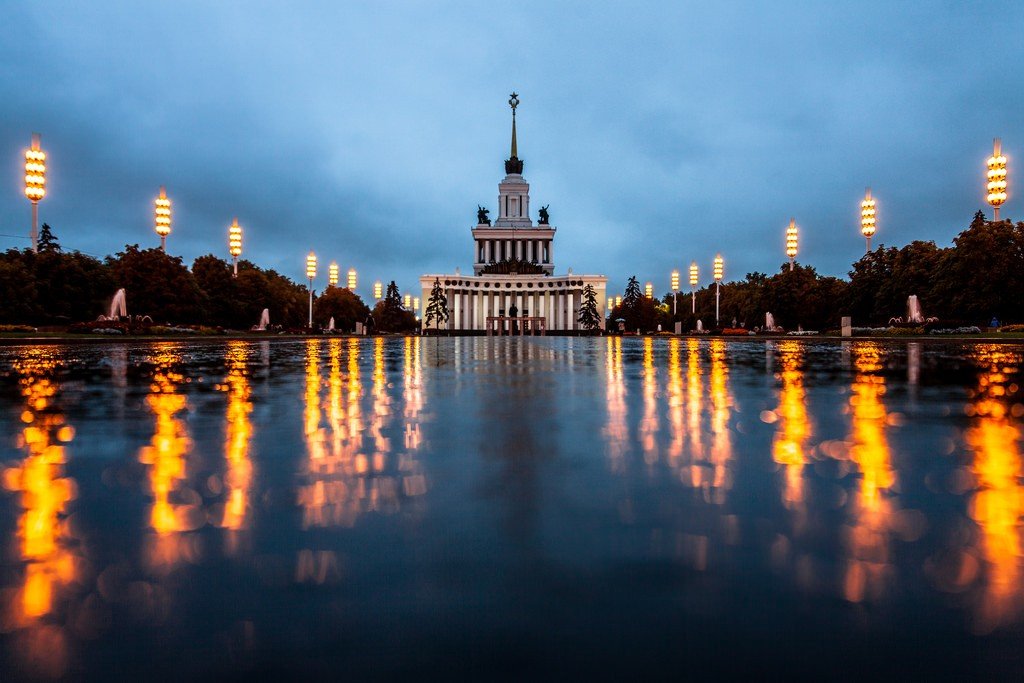
General information
In addition to expositions, museums and retail outlets at the All-Russian Exhibition Center there are huge modern sports grounds, amusement rides, a summer movie theater, a dolphinarium and not yet demolished unique objects of Stalinist architecture. It is very good to come here with children.
.Near the Northern Entrance, there is now a newly restored 24-meter sculptural group “Worker and Kolkhoz Woman” by Vera Mukhina. The sculpture has also become a symbol of the Mosfilm film studio. There is a legend that a colleague wrote a denunciation on Mukhina while she was working on the sculpture “Worker and Collective Farm Woman”, claiming that the folds of the collective farmer’s skirt showed Trotsky’s profile.
.But the best place to start a walk around the All-Russian Exhibition Center is the Main Entrance, which can be reached on foot from the VDNKh metro station. The pavilions of the park are numbered so that they can be bypassed, moving in a circle from left to right – clockwise.
.Main Entrance
The majestic 32-meter arch through which visitors enter the All-Russian Exhibition Center is a historical and cultural monument of state importance. It was created in 1954 according to the plan of architect Melchakov. Designing the Main Entrance, he focused on the classical heritage of Ancient Greece and Rome. One of the traditional symbols, the Arc de Triomphe, was used to express the theme of the victory of the Soviet people in the Great Patriotic War.
.The huge exhibition park required a monumental entrance, and this task was perfectly fulfilled. Look closely: on the columns – large bas-reliefs, the main theme of which – the labor of people. The solemn composition is crowned by the sculptural group “Tractor Driver and Collective Farm Woman.”
.
Pavilion No. 1 “Central”
Originally, the pavilion’s exposition reflected the stages and successes in building a socialist state in the Soviet Union as a whole. Now the most interesting thing here is the bomb shelter under the building, which is open to the public.
It seems that not so long ago, “Civil Defense” was a compulsory school subject. Textbooks described in detail what is located under the Central Pavilion of the All-Russian Exhibition Center. But it is one thing to read, and quite another to see these rooms and imagine what 300 people must have felt here in the event of a nuclear attack. Of course, there are many rumors about such a mysterious object. VVC tour guides within the framework of the walk “Myths and Legends of the All-Russian Exhibition Center”, for which you can sign up by tel.: 8-903-1367176, 8-495-5443496, tell which of them are true and which are fictions.
.Also in Pavilion 1 is the permanent exposition “Secrets of the Underwater World”. The meter-long herbivorous piranhas literally jump out of the aquarium when they are fed bananas and apples. And their predatory relatives with greed and incredible speed rush to the bait of meat. It is known that if the piranhas are not fed in time, they can easily have breakfast with each other. A four-meter tiger python is dozing in a special enclosure. It eats infrequently – once a month it swallows a rabbit. Nearby swims an anaconda. Its favorite dish is rats. Visitors to the exhibition can see a real Nile crocodile and caiman turtle, snakehead turtles, as well as live sharks, which are already here, in captivity, had offspring.
.The exhibition is open daily from 10.00 to 18.00
.Pavilion No. 2 “Public Education”
This pavilion used to house the exposition “Cosmonautics in the USSR”, and now the Butterfly House is located on 300 square meters of Pavilion No. 2. There are fountains and tropical plants, 30 degrees of heat and 80% humidity, feeders with overripe fruit, saucers with sugar syrup and about 500 different butterflies and moths. If you want butterflies to land on you, dress brightly – then they’ll think you’re a flower. Just keep in mind that the fine for a spoiled butterfly is 1500 rubles.
.
Entrance ticket: adults – 250 rubles, children – 150 rubles. Children under 3 years of age entrance is free. Bride and groom, as well as their witnesses on the day of the wedding – admission is free. Organizers recommend lovers to arrange romantic dates in this museum
.Friendship of Peoples Fountain
The visiting card of the All-Russian Exhibition Center – the “Friendship of Peoples” fountain with real gold leaf – was installed in 1954, when the exhibition was opened after the war. Today, 16 girls – according to the number of sister republics of the USSR – still lead a round dance. The VVC fountains are turned on by buttons and levers from the control room. They are inspected four times a day, and holes in the pipes are instantly patched; the Friendship of Peoples fountain is designed to be movable rather than static. Automation on the gate valves can change within an hour 15 water figures, but it is not turned on: save the fountain and save electricity.
.
Movie Park
Next to the fountain “Friendship of Peoples” at pavilion N9 2, a summer open-air “Cinema Park” is operating. It is designed for 200 seats. Modern movies on a 16-meter screen surrounded by ancient columns with stucco and under the starry sky acquire a completely different, romantic and nostalgic flavor.
.
All information about the repertoire and schedule of sessions can be found at www.kinopark.net. Ticket prices: from 200 to 400 rubles.
.
Pavilion 4 “Kyrgyzstan”
Originally it was an Estonian pavilion, but now it is actually a cultural center of Kyrgyzstan in Moscow. A good opportunity for visitors to the All-Russian Exhibition Center to get acquainted with Kyrgyz cuisine in the cafe “Polchatai.”
The pavilion stands out with a marble portico and majolica carpet pattern of the facade wall with the entrance portal. Small plaster sheaves of ears and slender columns add lightness and restraint to the architectural appearance. The facade is decorated with bas-reliefs on agricultural themes and natural ornaments in the manner of Kyrgyz folk art. The exterior of the pavilion is decorated with local stone and majolica, while the interior features carpentry and patterned rubber flooring.
.Pavilion No. 5 “Physics”
The former Latvian SSR pavilion has now become the site of the organization “Health League of the Nation”. There is a Health Center here, which sometimes holds free events like heart check-ups.
.
Attrapark rides
Attractions at the All-Russian Exhibition Center is Moscow’s largest entertainment park with a large selection of all kinds of carousels for children and several rides for adults: “Squadron”, “Space”, “Bell”, “Butterflies”. People also come here for fun on the water: “Canoes”, “Boats”, “Walking Balls”. On the American “Water Slide” you get a waterproof coat: the cabin twice goes out of the dive straight into the water. And on the “Condor” visitors spin around a pole at a height of 35 meters. On a walk through the labyrinths of the Mystery horror room zombie heads hanging at the entrance. But the main attraction is the “Free Fall Tower” – a 52-meter high pole, from the top of which you can fall in specially equipped cabins. This is where everyone who finds the Condor a child’s play seeks to go. “Tower” is easily recognizable by the crowd watching the daredevils from the ground, and the cries of the bravest.
.
Weekdays 10.00-22.00, weekends 10.00-23.00
.Pavilion No. 7 “Seeds”
The Seeds Pavilion was built 25 years later than the previous ones – in 1979 – and is very different in its architectural appearance. It is located on the Ring Road of the All-Russian Exhibition Center to the left of the Main Alley, between the South and Khovan entrances. The theme of the pavilion fully corresponds to the name, exhibitions and fairs on varieties and hybrids of vegetable and flower crops are held here, a shopping center “Everything for the homestead plot” operates.
.Pavilion No. 8 “Young Naturalists”
Under Soviet rule, this glass-domed pavilion housed halls for young technicians, animal breeders, plant breeders, a greenhouse and an exhibit area. Now the Exotic Birds Exhibition and the museum of fairy tales “Once upon a time.”
Exotic birds flutter in the greenhouse among tropical plants. Guests can observe the life and behavior of amadins, astrids, amaranths and birds of prey from Africa, Asia, . 10.00-20.00200 rubles for adults and 100 rubles. – for children The museum “Zhili-Byli” conducts theatrical tours, during which children travel through the pages of favorite Russian folk tales, as well as works by Russian and foreign writers. Through fairy tales the guests get acquainted with the culture of different nations, customs and traditions. Children go on these extraordinary journeys with their favorite characters, undergo tests to overcome evil and help good to triumph. During the excursion the children play, dance, reincarnate into ancient heroes, familiarize themselves with ancient objects. The collection of the museum is represented by household items, costumes, old dolls, books. Everything is available for tactile perception and is actively used in all programs. 10.00-19.00.500 rubles.
Dolphinarium
In 2011, the Dolphinarium was officially opened behind the VVC pavilion № 8. In the pool of 600 tons of filtered sea water, in which the “artists” feel quite comfortable. The main roles are played by two Black Sea afalines – Ramses and Bella, whale Casper and walrus Lyubasha. Millions of splashes, a storm of emotions and children’s laughter: every show is a real holiday.
.
Days and hours of performances: Monday, Tuesday – day off; Wednesday, Thursday, Friday – 18.00, Saturday, Sunday – 12.00, 14.00, 16.00, 18.00.
.Pavilion #9 “Young Technicians”
While most of the pavilions of the All-Russian Exhibition Center were built in 1954, the building on the site of the ninth, then called “Peat”, appeared before the war – in 1939. Today, the “Panopticon of Scientific Entertainment” opened in 2012 is working here.
Different eras harmoniously merged into one whole, and ingenious scientific inventions of the late XIX – early XX century neighbor with the most modern devices. Immersion in the atmosphere of the past, in the times of “mad” scientists provides a unique interior of the “Panopticon”, combining original elements of steampunk with the grandeur of Soviet neoclassicism.
.
More than 100 years later, Tesla’s famous “spooky tricks” now delight and delight visitors during the unique show “Megavolt – Lord of Lightning”. The action is accompanied by light effects and laser glow, a visual demonstration of the interaction of lightning with various objects and substances. As soon as the hall thunder discharges and lightning flashes – the mysterious man will fearlessly enter the cage with Tesla Coils.
. Weekdays 13.00, 15.00, 18.00, weekends and holidays 13.00, 15.00, 17.00, 18.00, 19.00, closed on Mondays.500 rubles. Duration of the performance – 40 min..Pavilion No. 13 “Health”
Before the war there was a pavilion of Armenia, now all the premises are occupied by trade rows of pharmaceutical firms. Here there are absolutely any goods on the subject and cheaper than in the city pharmacies. At the entrance medical consultants meet you with the offer to give information about the required product or to make free diagnostics. Once inside, raise your head above the signboards and admire the preserved elements of the decoration of the former Armenian pavilion.
.Pavilion No. 16 “Hydrometeorology”
The pavilion together with the weather station was built for the post-war opening of the All-Russian Exhibition Center in 1954 near the Khovansky entrance. The station still studies meteorological phenomena and makes weather forecasts. Once there was an automatic informer next to it, and anyone could find out the weather forecast by dropping a Soviet nickel into the coin receiver. But now you can see a real cannon for “dispersing clouds” on the left. True, the pavilion itself now sells seeds.
.There is no exposition, but the pavilion is classically beautiful, and VVC guides recommend going inside to see the interior.
.Pavilion No. 18 “Belarus”
The pavilion has been in this place since 1939! Today, the “Belarusian Trade and Exhibition and Information and Marketing Center” operates here.
.
The main facade of the pavilion is decorated with a monumental colonnade, behind which there is an open semicircular courtyard. The columns framing it are wrapped with colorful garlands of fruits, the front columns are decorated with colored majolica with national Belarusian ornaments, and the floor is lined with ceramic mosaics. The pavilion is crowned by a belvedere with the sculpture “Belarus” covered with gold smalt. It is also decorated with the sculptures of Belarusian citizens, which are dilapidated but have not lost their elegance.
.Square of Industry
At the very beginning of the design of the All-Russian Exhibition Center, a giant skyscraper pavilion “Mechanization and Electrification of Agriculture of the USSR” was built on the square. Then the dominant feature was a grandiose 25-meter monument-repeat “Stalin” by Merkurov, which immediately after the death of the leader was dismantled. Instead of it, a large circular pond was created, and the “Mechanization” pavilion completely changed its appearance and became very similar to a domed basilica. Later, the place in the center of the pond, where there was a statue of Stalin, was replaced by a model of the Vostok rocket, on which Yuri Gagarin took off into space on April 12, 1961. Three airplanes also appeared on the square, of which only the Yak-42 has survived to this day.”
.Airplane Gallery
It was on this prototype that aircraft designers and pilots tested the Yak-42 before putting it into mass production. According to one legend, to end up at the All-Russian Exhibition Center, this aircraft went for a landing from the side of the Ostankino Tower and landed right on the Main Alley, from where it was towed to the Cosmos pavilion. According to another legend, the plane landed near Riga Station, rolled down Mira Avenue and rolled into the Exhibition through the Main Gate.
.
In 2009, a new art platform was opened in the cabin of the legendary airliner. One of the pearls of domestic aircraft construction, which made a sensation in 1979 at the international air show in Le Bourget in France, and in 1981 set a world record for the range of non-stop flight, is now experiencing a second birth. However, the “Airplane” gallery works only in the warm season, from mid-April to mid-October..Weekdays 11.00-20.00, weekends 10.00-22.00. But the change of expositions takes place every 4-6 weeks.150 rubles. In addition to exhibitions on the basis of the gallery are various actions, flash mobs, workshops and master classes
.Pavilion 20 “Chemical Industry”
The huge glass building of the pavilion used to stand in the middle of the All-Russian Exhibition Center as a dull monument to the turbulent Soviet past. But recently it opened the largest indoor karting in Moscow. On the first tier there is a track, on the second tier there are galleries with a bar and a view from the panoramic windows to the All-Russian Exhibition Center. It is most fun to go karting in a company, then there is excitement. It is possible to crash into a jackhammer or into a neighboring kart, the only thing that it threatens is bruises. There are only two pedals in the car – gas and brake, which must be pressed alternately. Start in turn, and the time is counted individually. On the scoreboard then show who has the best time from the race, and give a printout of the result. The best results are recorded and you can compare your performance with them. Sneakers or sneakers are the ideal footwear. If you feel sorry for your clothes, you will be given a racing suit.
Race lasts 10 minutes and costs 600 rubles, separately rent a helmet and overalls – 50 and 100 rubles.
.
Wakepark
Wakepark is located in one of the most beautiful places of the All-Russian Exhibition Center – on the ponds of Zaprudnaya zone, closer to the Botanical Garden. Here everyone can experience the magical sensation of flying over water. The advantage is given to cable wakeboarding, when the movement of a person on the water is carried out with the help of a mechanized rope-towing installation, replacing the boat. In this case, the athlete rides the board holding on to the halyard and performs various tricks with the help of waves and springboards. Everything for extreme and safe riding is provided on the territory of the “Wake Park”.
.The distance is 170 meters long, here you can accelerate up to 50 km / h, but even professional athletes prefer to ride at a speed of only 20 km / h. For optimal gliding, visitors can choose between two boards: a wake board and a wake skate. For safety, everyone will be fitted with a wetsuit, helmet and life jacket.
Daily from 9.00 to 18.00.One minute of skating – 50 rubles, in addition, there are subscriptions and special rates
.A small room, inside which honey is sold and beekeeping equipment is exhibited. Behind this pavilion, on the bank of the pond, there is a cafe of Georgian cuisine “Solnyshko”.
.
Pavilion No. 29 “Floriculture”
The pavilion was built in the late 60’s and works for its intended purpose – trade in flower crops, a design center for industrial and amateur floriculture. It is also home to one of the Tea Yard tea stores.
Pavilion #31 “Geology”
The pavilion was built before the war and was called “Flax, hemp and other bast crops”, now there is trade inside, but nothing forbidden is sold.
.Pavilion No. 32 “Cosmos”
Once this pavilion was the most important and largest at the All-Russian Exhibition Center – it was called “Mechanization and Electrification of Agriculture”. Now it is a trading rows “Everything for garden and vegetable garden.”
.Pavilion № 43 “Horse Breeding”
This pavilion has been proud of its horses for more than half a century. Today 18 elite exhibition breeds are represented here: Akhalteke, Orlov trotting, Hanoverian, Budennovo, Don, Arabian thoroughbred and others.
The exhibition is open: weekdays 13.00-16.00.Riding on horses, ponies and in a carriage takes place on the territory between the fountains “Friendship of Peoples” and “Stone Flower” 100-250 rubles.Riding time: Wednesday – Sunday 11.00-16.00.
.Fisherman’s Village and paintball club
The unique new complex is located in the Zaprudnaya zone near the Likhoborsky entrance. It provides round-the-clock fishing at any time of the year. On an ordinary rod you can catch sturgeon, carp, beluga weighing up to 20 kg. Right on the spot the caught fish will be cooked by cooks according to special recipes. By the summer season a trout river and a carp pond are opened on the territory of the Fishermen’s Village, there are rest houses and a Finnish bathhouse. 24 hours a day working rod rental, guarded parking lot, cafe Russian cuisine with a rich selection of fresh fish dishes: carp ear, smoked trout, crayfish.
.
On the territory of the village is a paintball club. Playground in the woods on the banks of the river is considered one of the best in Moscow. On it – about 30 different shelters, obstacle course, trenches. There is even a real self-propelled rocket launcher. Experienced instructors offer visitors up to 40 different game scenarios. On the territory of the paintball club you can also have a snack in the open air or shoot in the shooting gallery with a pump gun.
.Pavilion #53
The pavilion is located to the right of the Cosmos. It houses the Damo Center for the Study of Martial Arts and Health Practices. It is the official representation of the Shaolin Monastery in Russia. Here classes are held in the following areas: classes for children, kung fu, weapons classes, qigong, taijiquan, therapeutic massage, manual therapy, healing, meditative practices, hand-to-hand combat, karate, aikido-aikikikai, katori shintoryu, iaijutsu, women’s self-defense, all-around, jiu-jitsu, taekwondo, ninjutsu, capoeira, kai do, dynamic qigong massage, dances of various styles, northern tradition, Slavic gymnastics, hatha yoga, raja yoga, tea meditation, health practices. The team of instructors is regularly trained in Shaolin Monastery in China.
.Stone Flower Fountain
The “Stone Flower” fountain was created in 1954 according to Topuridze’s design. It is located on the Kolkhoz Square. It was once used as a fire reservoir when a nearby pavilion caught fire. The fountain is full of colors, glow of smalt and lush sculptural details – it is as if it was invented for the scenery of Bazhov’s fairy tales. The perimeter of the pool is decorated with bird figures, molded fruits and gifts of the fields. Water jets are also beating from them. All this creates a beautiful joyful scene. “Stone Flower” became the world’s first light and music fountain. The great Soviet composer Shostakovich wrote the “Festive Overture” especially for it.”
.Pavilion No. 58 “Ukraine”
This pavilion is considered one of the most beautiful at the All-Russian Exhibition Center. It was built in 1939 for the Ukrainian SSR and rebuilt in the same form with capital constructions in 1954 and was named “Agriculture”, and now it is called “Ukraine” again.
Basillium Circus Theater
Between pavilions 64 and 66 on the Main Alley of the All-Russian Exhibition Center, next to the fountain “Friendship of Peoples” is a circus-theater of improvisations, experiments and eclecticism “Basillium”. Instead of a round arena – a stage, instead of rows with chairs – round tables with candles.
.Basillium specializes in theatrical performances of a synthetic genre that combines the traditions of circus, variety show and theater. At the same time it reminds of Cirque du Soleil, Eloise, Vyacheslav Polunin’s show and Moulin Rouge. Among the participants are actors who worked in “Cirque du Soleil” and “Lycée”. The performances are shown in a white tent, which is exactly the same shape as the Circus of the Sun.
.
Performances: Friday 19.00, weekends 17.00.Children’s – 500 rubles, adult – 900 rubles.
.
Museum of Animation
In the relatively new building No. 84 you can organize a review and cognitive excursion into the history of world and domestic animation. Every hour in the museum there are organized group tours with demonstration of cartoons, documentaries about the history of the oldest domestic film studios, master classes. Here are collected not only technical devices that once contributed to the development of animation, but also generated by it the most vivid images – from Mickey Mouse to Cheburashka.
In the “Workshop” section, young animators can create their own cartoon. “Cinema Hall” – a specially equipped room where visitors watch not only cartoons that have become classics of the genre, but also their own work. Moscow Museum of Animation at the All-Russian Exhibition Center is open for both group and individual visits. Here you can sign up for a master class on creating cartoons and even celebrate a child’s birthday.
.Weekdays 11 a.m.-6 p.m., weekends 11 a.m.-7 p.m., closed on Mondays
.Pavilion No. 69 “Consumer Goods”
The pavilion is a vivid example of the trends of the 70s-80s in Soviet architecture. Its author Igor Mikhailovich Vinogradsky is world-famous for works in the aile of brutalism. The asymmetrical composition and elegantly drawn entrance portals give a unique look to the building. The Union of Architects of the USSR awarded this pavilion with a diploma in the competition of the best buildings of 1986.
.
At present, Pavilion No. 69 is the largest in terms of exposition area and remains one of the main venues of the All-Russian Exhibition Center for exhibitions and fairs, most often religious ones. The pavilion has several cafes and all the exhibition infrastructure.
.
Pavilion No. 70 “Moscow”
The pavilion was built in 1967 and moved to Moscow after the exhibition in Montreal, Canada, where it was popularly known as “Flying Roof”. Critics of the Soviet system have calculated that transportation and restoration of the structure in Moscow cost several times more than if it had simply been built anew at the All-Russian Exhibition Center.
.
Today, Orthodox exhibitions are often held here. For sale – herring from monasteries and expensive tourist vouchers, everything for the garden and vegetable garden and ritual funeral supplies. And, of course, at any time of the year – “Furs at VDNKh”, without which no well-to-do worker of the former Soviet Union can do without.
.
Pavilion No. 71 “RSFSR”
Today, inside the Russian pavilion is the “Ice Age” paleontology museum. This museum-theater is conceived as a scientific exposition center promoting knowledge about the Ice Age through vivid impressions and at the same time exhibiting rare finds of scientific importance. The core of its exposition deals with the life of animals and humans in the harsh conditions of northeastern Russia during one of the coldest ice ages in the history of the earth.
.
Opening the exposition is the hall where “contemporaries of the mammoth” are presented. Here is the world’s largest collection of skulls and horns of the woolly rhinoceros, skeletons and skulls of primitive bison, cave bears, the skeleton of a fossil wolf, mummified remains of soft tissues of long extinct animals, as well as a unique skull of a cave lion. The main attraction of the whole museum is a group of mammoths on a rotating podium, made life-size as they looked many millennia ago. The sharpness of perception is enhanced by sound and light effects. The uniqueness of the museum-theater “Ice Age” is that everything is real and can be touched with your hands.
.
Pavilion 75 “International Exhibition Center MosExpo”
The newest and largest pavilion of the All-Russian Exhibition Center, opened in 2008. It regularly hosts exhibitions and fairs.
.Аттракционы «Москва-850»
At the entrance to another VVC amusement park, visitors are greeted by a large trampoline. Nearby, the park guests swing on the giant swing “Mars” and squeal, entering a dead loop on the ride “Cobra”. There is also an alley of all kinds of shooting galleries, a classic “Hammer”, a basketball hoop and other entertainment for those who want to win a prize. Works 50-cinema, where the effect of presence is formed not only due to the three-dimensional image, but also due to the moving vibrating chair, splashing water and spreading odors. The chair conveys the sensation of falling into the abyss or acceleration, so viewers can plunge into “Attack of the Viruses” or participate in “Extreme Racing”. Some rides from the renovated Gorky Park have moved here: “Black Hole”, “Big Ben”, “Fly Machine”, “Break Dance”, “Chain Carousel”. But the main attraction is still the Ferris wheel “850th anniversary of Moscow”, the largest in Europe – its height is 73 meters.
.Daily 13.00-21.00
.